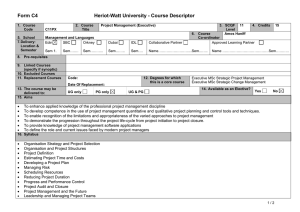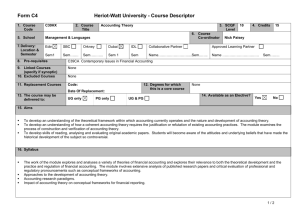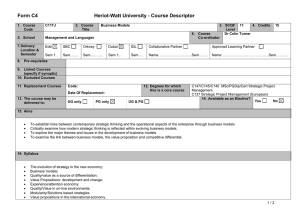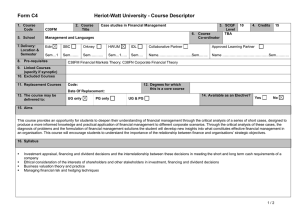The University of North Carolina at Chapel Hill Fall Semester, 2008
advertisement
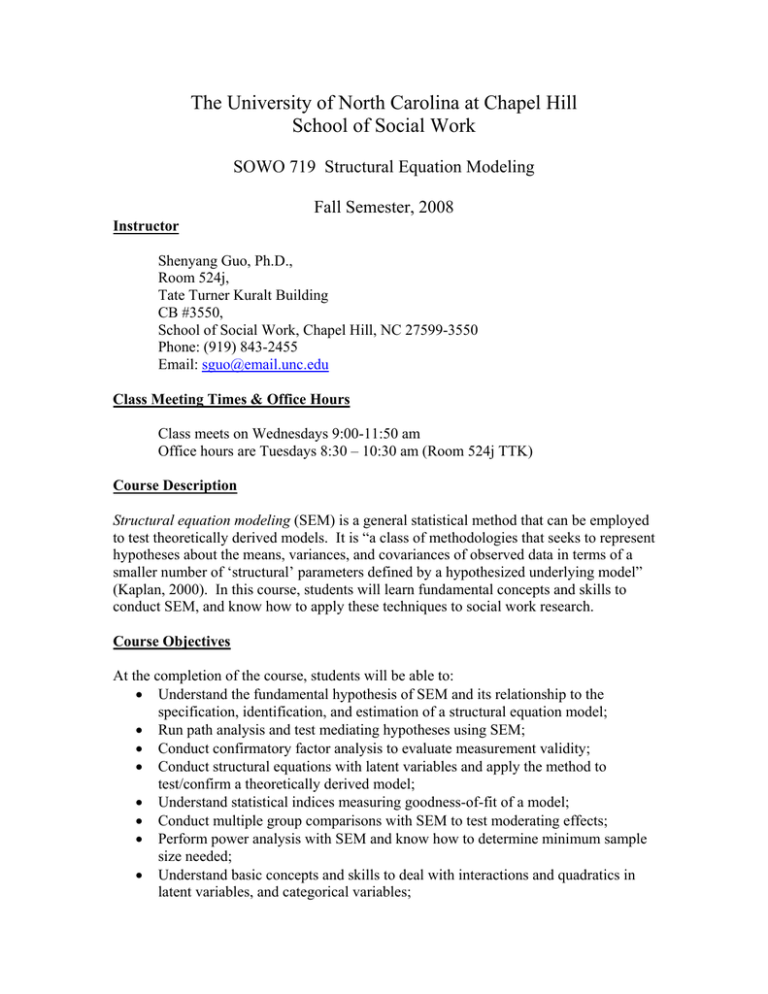
The University of North Carolina at Chapel Hill School of Social Work SOWO 719 Structural Equation Modeling Fall Semester, 2008 Instructor Shenyang Guo, Ph.D., Room 524j, Tate Turner Kuralt Building CB #3550, School of Social Work, Chapel Hill, NC 27599-3550 Phone: (919) 843-2455 Email: sguo@email.unc.edu Class Meeting Times & Office Hours Class meets on Wednesdays 9:00-11:50 am Office hours are Tuesdays 8:30 – 10:30 am (Room 524j TTK) Course Description Structural equation modeling (SEM) is a general statistical method that can be employed to test theoretically derived models. It is “a class of methodologies that seeks to represent hypotheses about the means, variances, and covariances of observed data in terms of a smaller number of ‘structural’ parameters defined by a hypothesized underlying model” (Kaplan, 2000). In this course, students will learn fundamental concepts and skills to conduct SEM, and know how to apply these techniques to social work research. Course Objectives At the completion of the course, students will be able to: • Understand the fundamental hypothesis of SEM and its relationship to the specification, identification, and estimation of a structural equation model; • Run path analysis and test mediating hypotheses using SEM; • Conduct confirmatory factor analysis to evaluate measurement validity; • Conduct structural equations with latent variables and apply the method to test/confirm a theoretically derived model; • Understand statistical indices measuring goodness-of-fit of a model; • Conduct multiple group comparisons with SEM to test moderating effects; • Perform power analysis with SEM and know how to determine minimum sample size needed; • Understand basic concepts and skills to deal with interactions and quadratics in latent variables, and categorical variables; • • Understand the linkage between SEM and hierarchical linear models, and conduct multilevel analysis and latent growth curve analysis with SEM; Understand strategies dealing with missing data. Pre-requirement Students are assumed to be familiar with descriptive and inferential statistics. A solid understanding of multiple regression analysis is a key. They should have statistical and statistical software background at least equivalent to that provided by SOWO919 (applied regression analysis and generalized linear models), SOCI209, PSYC282, EDUC284 (linear regression), or SOCI211 (categorical data analysis). Software Packages Students may choose to use SAS, SPSS, or Stata as the primary statistical software package for data management and non-SEM statistical analysis, though the classroom lectures and materials will be based on SAS. The course will employ AMOS as the main software package for running SEM. It will also teach students how to run LISREL and Mplus to meet special needs. Textbooks Kline R.B. (2005). Principles and practice of structural equation modeling, Second edition. New York, NY: the Guilford Press. Byrne, B.M. (2001). Structural Equation Modeling with AMOS: Basic Concepts, Applications, and Programming. Mahwah, NJ: Lawrence Erlbaum Associates, Inc. Bollen, K.A. (1989). Structural equations with latent variables. New York, NY: John Wiley & Sons. (recommended but not required) Kaplan, D. (2000). Structural Equation Modeling: Foundations and Extensions. Thousands Oaks, CA: Sage Publications. (recommended but not required) Readings about Applications of SEM to Social Work Research A reading list of 139 articles, compiled by Shenyang Guo and Chung-Kwon Lee, will be made available to students. These articles are applications of SEM to social work research. We compiled the list by reviewing all articles in eight social-work or socialwork-related journals published from January 1, 1999 to December 31, 2004. These articles will be used in classroom lectures as social work examples. They will also serve as a useful literature base for students to learn various applications of SEM to social work problems. 2 Assignments Assignment 1 Assignment 2 Assignment 3 Assignment 4 Assignment 5 Midterm Exam (take home) Final Exam (take home) Grade Percentage 10% 10% 10% 10% 10% 25% 25% Grading System The standard School of Social Work interpretation of grades and numerical scores will be used. H = 94-100 P = 80-93 L = 70-79 F = 69 and below Policy on Class Attendance Class attendance is an important element of class evaluation, and you are expected to attend all scheduled sessions. Each class session will cover a great deal of materials, and you will fall behind the course when you miss even one class session. It’s student’s responsibility to inform the instructor via email in advance for missing a class session. You are expected not to miss more than two sessions for the whole semester. Starting from the second missing, your course grade will be reduced by 10% for each session missed. Policy on Incomplete and Late Assignments Assignments are to be turned in to the professor by 5pm of the due date noted in the course outline. Extensions may be granted by the professor given advance notice of at least 24 hours. Late assignments (not turned in by 5pm on the due date) will be reduced 10 percent for each day late (including weekend days). A grade of incomplete will only be given under extenuating circumstances and in accordance with University policy. Policy on Academic Dishonesty Students are expected to follow the UNC Honor Code. Please include the honor code statement along with your signature on all assignments: “I have neither given nor received unauthorized aid on this assignment.” Please refer to the APA Style Guide, the SSW Manual, and the SSW Writing Guide for information on attribution of quotes, plagiarism and appropriate use of assistance in preparing assignments. 3 If reason exists to believe that academic dishonesty has occurred, a referral will be made to the Office of the Student Attorney General for investigation and further action as required. Policy on Accommodations for Students with Disabilities Students with disabilities which affect their participation in the course may notify the instructor if they wish to have special accommodations in instructional format, examination format, etc., considered. Description of the Assignments Assignment 1: Solving problems of basic matrix algebra and covariance algebra. Assignment 2: Running AMOS to solve problems of path analysis and regression analysis; and solving problems related to the decomposition of direct and indirect effects. Assignment 3: Exercises of running confirmatory factor analysis, test construct validity, and compare models with different dimensionality. Assignment 4: Exercises of running the general structural equation models (i.e., the latent variable and measurement models combined). Assignment 5: Critical review of studies applying SEM to social work problems; and exercises of power analysis. Midterm exam: Use the provided or student-chosen data set to perform a confirmatory factor analysis, develop a scale that shows adequate validity and reliability, and present the findings in a clear and organized fashion. Final exam: Use the provided or student-chosen data set to run a general structural equation model, test group differences, mediating effects, and present the findings in a clear and organized fashion. Outline of Course Topics and Readings 8/20/08: Introduction to SEM and course overview Required readings: Kline Chapter 1, Byrne Chapter 1 8/27/08: Preliminaries (Part I): Basic matrix algebra 1. Matrix operations 2. Properties of matrix operations 3. Applications of matrix algebra to statistical analysis 4 4. The eight basic matrices of SEM Required readings: Bollen (1989), Appendix A (Hand out Assignment 1, due 9/10/08) 9/3/08: Preliminaries (Part II): Covariance algebra, correlation, and regression 1. Covariance (expectation) algebra 2. Standardization, covariance, and correlation 3. Regression, partial correlation, multiple correlation 4. Statistical assumptions of regression and diagnostics Required readings: Kline Chapters 2 & 3 Hays, W. L. (1981) “The algebra of expectations”, in Statistics for Psychologists, 3rd Edition (pp. 667-671), New York: Holt, Rinehart and Winston. 9/10/08: Path analysis & running AMOS 1. Path analysis 2. Total, direct, and indirect effects 3. Overview of running AMOS Required readings: Kline Chapters 4 & 5, Byrne Chapter 2 (Hand out Assignment 2, due 9/24/08) 9/17/08: Model specification, identification, and estimation 1. Steps in running SEM 2. The fundamental hypothesis 3. Theoretical model and SEM specification 4. Identification 5. Estimation 6. Goodness-of-fit indices Required readings: Kline Chapter 6 9/24/08: Confirmatory factor analysis (Part I) 1. Three types of measurement models: parallel, Tau-equivalent, and congeneric 2. Construct validity 3. Test multidimensionality in CFA Required readings: Kline Chapter 7, Byrne Chapters 3 & 4 (Hand out Assignment 3, due 10/8/08) 10/1/08: Confirmatory factor analysis (Part II) 1. Implied covariance matrix of CFA 2. Identification rules 3. Estimation 5 4. Second-order CFA model Required readings: Byrne Chapter 5 10/8/08: General SEM (Part I): Latent variable and measurement models combined 1. Implied covariance matrix 2. Identification rules 3. Estimation 4. Evaluation and modification of models Required readings: Kline Chapter 8, Byrne Chapter 6 (Hand out midterm exam, due 10/22/08) 10/15/08: No Class. Happy Fall Break! 10/22/08: General SEM (Part II): Nonrecursive model and other issues 1. Nonrecursive models 2. Identification in running nonrecursive models 3. Modification indices 4. Goodness-of-fit indices Required readings: Kline Chapter 9 Gerbing, D.W., & Anderson, J.C. (1993). ”Monte Carlo evaluations of goodness-of-fit indices for structural equation models”, in K.A. Bollen & J.S. Long (Eds.) Testing Structural Equation Models (pp.10-39). Newbury Park, CA: Sage publications, Inc. Hu, L., & Bentler, P.M. (1999). “Cutoff criteria for fit indices in covariance structure analysis: conventional criteria versus new alternatives”, Structural Equation Modeling 6(1): 1-55. Marsh, H.W., Balla, J.R., & Hau, K. (1996). “An evaluation of incremental fit indices: A clarification of mathematical and empirical properties”, in Marcoulides & Schumacker (Eds.) Advanced Structural Equation Modeling (pp.315-353). Mahwah, NJ: Lawrence Erlbaum. (Hand out Assignment 4, due 11/5/08) 10/29/08: Multiple-group comparison and power analysis for SEM 1. Multiple-group comparisons 2. Test moderating effects with SEM 3. Power analysis for SEM Required readings: Byrne Chapters 7 & 10, Kline Chapter 11 MacCallum, R.C., Browne, M.W., & Sugawara, H.M. (1996). “Power analysis and determination of sample size for covariance structure modeling”, Psychological Methods 1(2): 130-149; and 6 MacCallum, R.C., Browne, M.W., & Cai, L. (2005, unpublished manuscript). “Testing differences between covariance structure models: power analysis and null hypothesis”. 11/5/08: Statistical assumptions underlying SEM and corrective strategies 1. Non-normality and strategies 2. Create polychoric and polyserial correlations using LISREL/PRELIS 3. Heteroscedastic errors 4. Interactions and quadratics in latent variables 5. Categorical variables Required readings: West, Finch, & Curran, (1995). “Structural equation models with nonnormal variables”, in R. Hoyle (Eds.) Structural Equation Modeling (pp.56-75). Thousands Oaks, CA: Sage Publications, Inc. Bollen, K.A. (1996). “A limited-information estimator for LISREL models with or without heteroscedastic errors”, in Marcoulides & Schumacker (Eds.) Advanced Structural Equation Modeling (pp.227-242). Mahwah, NJ: Lawrence Erlbaum. Bollen, K.A., & Paxton, (1998). “Interactions of latent variables in structural equation models”, Structural Equation Modeling 5(3): 267-293. Bollen, K.A. (1995). “Structural equation models that are nonlinear in latent variables”, in P.M. Marsden (Ed) Sociological Methodology 1995 (pp.223-251). Cambridge, MA: Blackwell. Joreskog, K.G., & Yang, F. (1996). ”Nonlinear structural equation models: The KennyJudd Model with interaction effects”, in Marcoulides & Schumacker (Eds.) Advanced Structural Equation Modeling (pp.57-88). Mahwah, NJ: Lawrence Erlbaum. Hipp, & Bollen, K.A., (2003). “Model fit in structural equation models with censored, ordinal, and dichotomous variables: Testing vanishing tetrads”, in Sociological Methodology 2003. (Hand out Assignment 5, due 11/19/08) 11/12/08: Mean structure and multilevel analysis 1. The mean structure model versus the covariance structure model 2. Treat intercept and slopes as latent variables 3. Multilevel analysis with SEM 4. Similarities and differences between SEM and HLM Required readings: Kline Chapter 10, Byrne Chapter 9 Hox, J.J., (2000). “Multilevel analyses of grouped and longitudinal data”, in Todd, D. Little, Kai, U. Schnabel, & Jurgen Baumert (Eds.) Modeling Longitudinal and Multilevel Data (pp.15-32). 11/19/08: Longitudinal analysis with SEM 1. Panel model 2. Latent growth curve analysis 7 Required readings: Aish, A., & Joreskog, K.G. (1990). “A panel model for political efficacy and responsiveness: An application of LISREL 7 with weighted least squares”, Quality & Quantity 24: 405-426 Pandey, S., & Coulton, C. (1994). “Unraveling neighborhood change using two-wave panel analysis: A case study of Cleveland in the 1980s”, Social Work Research 18(2):83-96. Willett, J.B., & Sayer, A.G. (1994). “Using covariance structure analysis to detect correlates and predictors of individual change over time”, Psychological Bulletin 116(2): 363-381. Chou, C., Bentler, P.M., & Pentz, M.A. (1998). “Comparisons of two statistical approaches to study growth curves: the multilevel model and the latent curve analysis”, Structural Equation Modeling 5(3): 247-266. Curran, P.J., & Willoughby, M.T. (2003). “Implications of latent trajectory models for the study of developmental psychopathology”, Development and Psychopathology 15: 581-612. (Hand out final exam, due 12/5/08) 11/26/08: No Class. Happy Thanksgiving! 12/3/08: Extensions and Course summary 1. Bootstrapping 2. Handling missing data 3. Overview of Mplus 4. Reporting results of SEM 5. Common pitfalls in applying SEM 6. Directions for future research Required readings: Byrne Chapters11 &12 Arbuckle, J.L. (1996). “Full information estimation in the presence of incomplete data”, in Marcoulides & Schumacker (Eds.) Advanced Structural Equation Modeling (pp.243-278). Mahwah, NJ: Lawrence Erlbaum. Kline Chapters 12 & 13 Boomsa, A. (2000). “Reporting analyses of covariance structures”, Structural Equation Modeling 7(3): 461-483. 12/5/08: Final exam due 8
